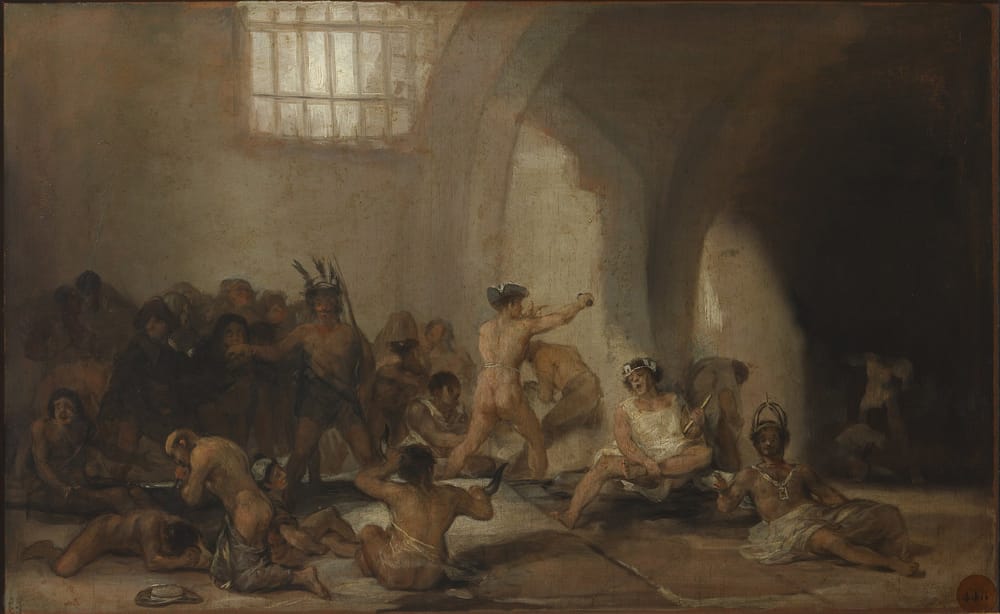“The theatre of cruelty,” wrote Antonin Artaud:
“. . . has been created in order to restore to the theatre a passionate and convulsive conception of life, and it is in this sense of violent rigour and extreme condensation of scenic elements that the cruelty on which it is based must be understood. This cruelty, which will be bloody when necessary but not systematically so, can thus be identified with a kind of severe moral purity which is not afraid to pay life the price it must be paid.”
Artaud wanted to combine aggressive theatrical displays with disciplined technique, to shake the audience out of the confines of bourgeois existence and reconnect them with the primally spiritual. Artaud, Susan Sontag wrote, wanted to show “the organic basis of emotions...in the bodies of the actors” through “art as an ordeal”. At the risk of sounding like a New Yorker essay that attained sentience and began malfunctioning, I could not help thinking about Artaud as I watched a rerun of Combat Zone Wrestling's 2001 event Un F'n Believable.
I love professional wrestling. Other people watch HBO serials and Netflix documentaries. I watch pro wrestling. It is not a guilty pleasure because I feel no shame. I do feel awkward, though, when I watch Combat Zone Wrestling. CZW, as it is known, sprang into existence very much as a product of its time. “Extreme” wrestling—along with Mixed Martial Arts, Jackass, nu-metal and Fight Club—resisted a creeping suburban boredom that had snuck up on the well-fed but complacent West of the 1990s. CZW took all the danger and sadism of its spiritual father, Extreme Championship Wrestling, and turned it up to twelve. Something about the ramshackle recklessness of its early years is oddly compelling—and, oftentimes, nauseating.
There is something quaint about the fact that while Un F'n Believable featured men being hurled into barbed wire, cracked over the head with light tubes, struck with panes of glass and set alight, they were compelled to not use the f-word. There were standards, you see.
All of these acts of violence took place in a single “deathmatch” that pitted the team of Justice Pain and Johnny Kashmere against the team of Sick Nick Mondo and Jun Kasai. A “deathmatch” is a professional wrestling spectacle in which traditional moves are mixed with weapons such as light tubes, barbed wire, glass, beds of nails and thumbtacks—as well, most dangerously, as high-flying stunts. It is, in essence, an exhibition of one's willingness to risk one's life and withstand pain.
Two questions that any normal person would have if they watched the deathmatch at Un F'N Believable are “how is this legal” and “how are these guys not dead”. Kashmere is pushed off one of the turnbuckles of the ring through a cluster of light tubes. Pain is powerbombed through a barbed wire board. Kasai is thrown out of the ring through a table on which yet more light tubes are stacked. Meanwhile, men and women watch as shards of glass fly.
There is a surreal quality to deathmatches. Comically absurd weapons appear, like an acoustic guitar to which light bulbs have been fixed. Graceful acrobatics, like Mondo's powerbomb, in which he flips over Justice Pain's head, grabs him around the waist and hammers him onto his back, are set against naked brutality, like the coils of barbed wire lurking underneath them. Somehow, there is a morbid beauty to a pane of glass being broken like the surface of a lake when pierced by a swimmer.
Deathmatches are often “matches” only tenuously, even by the theatrical logic of professional wrestling. Golden opportunities to pin opponents to the mat are spurned in favour of chances to inflict more graphic and creative punishment. In fact, it is a curious feature of “hardcore” wrestling in general that performers can be admired more for the moves they take than the moves they give. Mick Foley, who was thrown off and through a metal cage in the World Wrestling Federation's 1997 event King of the Ring, is the prototype here.
The match between Pain, Kashmere, Mondo and Kasai is gruelling enough, but what is more striking is what CZW aired afterwards: Jun Kasai having the gashes in his back cleaned up. Poor Kasai bends forward, with his hands on his knees, and grits his teeth as a nurse rubs disinfectant on a cut so deep that you could push your finger into his flesh, and so wide that it spans the length of his upper body. A voice chimes in to say Kasai is agitated because he is scared of needles, and the nurse—who appears to be wearing a shirt that says “Meat Control”—bursts out laughing. Later, a smiling Kasai politely asks someone to take his photograph, as the camera zooms in to look at a hole in his elbow, through which his muscle is protruding.
I suspect at least some of the people who, like me, feel a bit dirty when they watch more openly brutal forms of wrestling will feel doubly so if they watch Kasai getting treated. But to the extent that deathmatch wrestling is a uniquely sordid spectacle, which it is, it has more to do with what it symbolises than its actual results. Having yakitori sticks driven into your scalp, or being thrown into barbed wire, entails an acutely sadistic resonance. It does not help somebody pin you to the mat. It just hurts. But you cannot get out of moralism by covering it up in compassion. This kind of “move” is less dangerous than traditional maneuvers like piledrivers or powerbombs. A normal wrestling match would never leave performers in the state that deathmatch wrestling leaves Kasai but the attritional effect of constant “bumps” on the condition of one's joints, ligaments, and, in some cases, brain can be just as devastating in the long term. To appreciate that you would have to see a wrestler trying to get out of bed without the use of pain pills.
Justice Pain died this year at the age of 41. Johnny Kashmere has become a sort of inspirational slash motivational speaker. Nick Mondo retired after taking the most famous “bump” in independent wrestling, in which he was powerbombed off the roof of a building, and later made a documentary, The Trade, in which he explored his attraction to deathmatch wrestling and suggested that it was the product of a masochistic fixation on pain as a means of redemption.
Only Jun Kasai is still an active wrestler, with a body covered in scars and a giant chunk of flesh missing from his back. In a Viceland documentary, he talked about his childhood. “I looked forward to pro wrestling every week,” he said:
My father would come home from work really tired and he'd sit next to me and we'd watch together.
He'd say stuff like, “That move didn't hurt. That move wouldn't do any damage.”
So if I was going to wrestle I wanted a match my dad couldn’t say that about.
The desire for more visceral thrill than can be found in soul-draining office work and bourgeois domesticity is obvious. But it is the attachment to authenticity that defines the self-image of deathmatch wrestling. The contest might be inauthentic, as has been made painfully clear to more—and, ultimately, all—fans of professional wrestling in modern times. But the pain is authentic, and, in the bloody spectacle of the deathmatch, undeniably so. This becomes a badge of morbid legitimacy. David Arquette, of Scream fame, regretfully earned a place in wrestling’s Hall of Shame when he was booked to win the World Championship Wrestling heavyweight championship. Almost two decades afterwards he earned the respect of wrestling fans when he took part in an improbable but brutal deathmatch with the notoriously vicious “Hardcore” Nick Gage.
Deathmatch wrestling has maintained a dark niche, in the US scene, through CZW and Game Changer Wrestling, and in Japan, through Big Japan Pro Wrestling. In its small way it has been an outlet for the bloodlust that still festers in civilisation. Our times remain violent, but the violence has been covered up or outsourced to machinery. Wars have dragged on in the Middle East, but through low-level guerrilla attacks and the inhuman operations of drones. Untold millions of animals are cruelly confined and slaughtered every year, but the average consumer has no sense of how a pork chop ends up in Trader Joe’s. Even the shock we felt when we watched the brutal killing of George Floyd, and the spasms of rioting that followed, was inflected with naivety, as if there is no constant drumbeat of killings on US streets.
None of this means people have it easy. Chronic pain has been rising, but in most cases this has had less to do with extremes of physical exertion than with age, obesity, inactivity, drug overuse and the mental strain of depression, loneliness and stress. It is pain without as much as ennobling origins—an enfeebling decline. Mass society is able to abstract and mysticize its costs.
In a sense, deathmatch wrestling inverts this paradigm. Rather than being civilised barbarity it is barbarically civilised. The appearance of primal, sadistic aggression obscures skilled and dedicated efforts not to cause long-term injury and death. One could take that point too far. Of course, no one with a conscientious interest in preserving people's long-term health would encourage them to jump off buildings. But when you consider the hair-raising narrowness of the margin of error between throwing someone painfully but safely onto their back and throwing them onto their head, you have to appreciate the craft.
“It’s not healthy to purposely destroy yourself,” said Nick Mondo in a charmingly double-ended admission. It isn't very healthy to watch people destroy each other either, though it is an interesting epiphenomenon. It speaks to a discomfort with comfort—and a sense of pain as being a means of escaping the tendrils of complacence. It speaks of a rejection of the stylistic humanism which deplores explicit manifestations of cruelty while overlooking its subtle and subterranean forms. But fetishizing pain as an end in itself, in wrestling and the real world, only inspires its replication and maximisation. Absent of a goal towards which pain can be directed, one never transcends suffering but sinks deeper into one's wounds.
Ben Sixsmith is an English writer living in Poland who has written for The Spectator USA, First Things, Quillette, the Washington Examiner and others. He invites you to follow him on Twitter.




